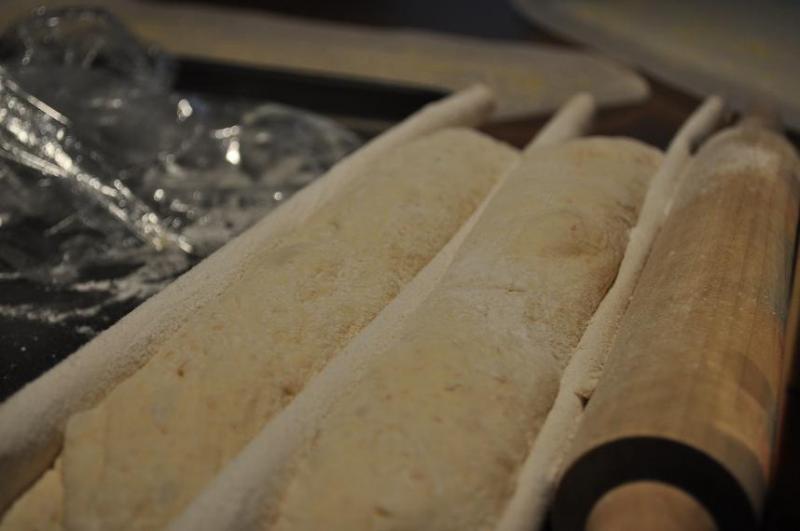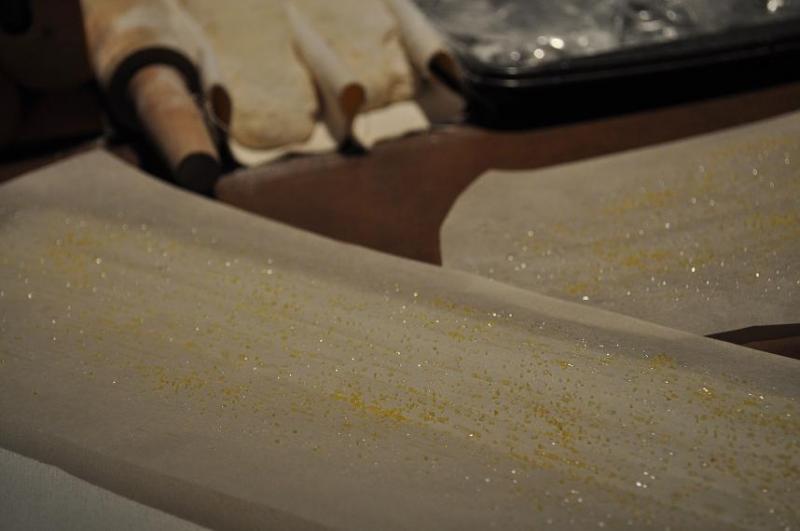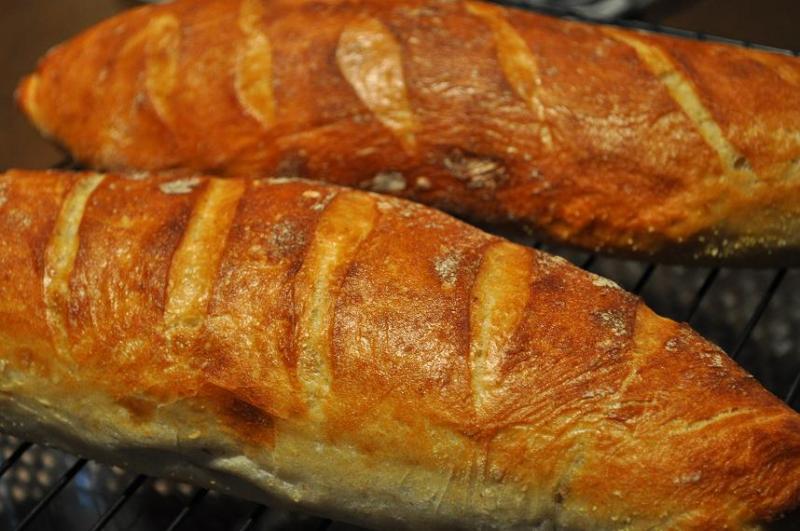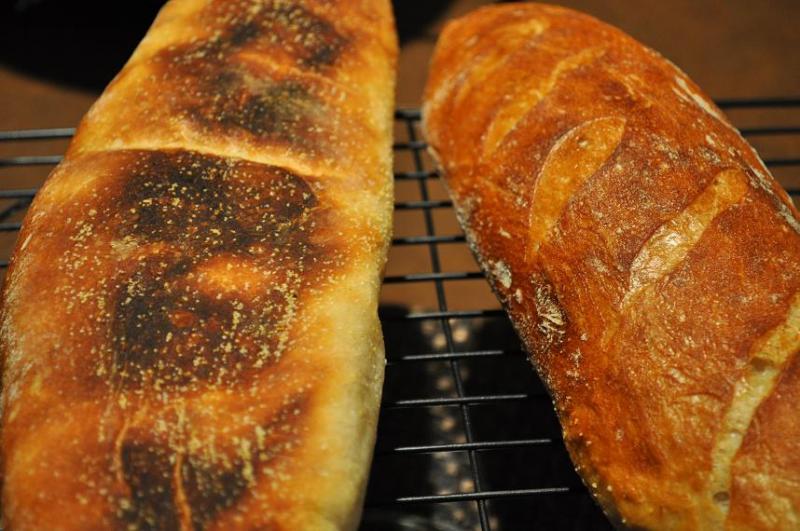I tried my 1st go at baguettes today/yesterday. The recipe I chose to try (because my sourdough starter recently died and haven't developed a new one yet) is a riff on Bouabsa's Baguettes. Key problem here is the word I used, RIFF. Why the heck would I riff on a bread recipe for a bread that I have never tried before, and was quite nervous trying?? I don't know. I am slowly learning many lessons by my mistakes.
The changes I irresponsibly made to the original recipe was to add 10 grams of light rye flour and 45 grams of whole wheat flour to the overall formula. I adjusted a bit of hydration for the WW addition, but I think perhaps it was a bit too much added. The dough very much resembled the Tartine Country dough during the S&F's and shaping.
Everything seemed to look good after the 22 hours of fridge retarding:

Parchment paper with a bit of oil/corn meal

When I transfered the proofed dough onto the parchment, they spread out a little more than I would have liked. This could be due to the high hydration? I slashed them nervously and sloppily and threw them into my roaster steam bake method and into the oven at 480 degrees.
They turned out a bit uneven in colour, bit burnt on bottom, and overall, just not looking how one would want in a baguette. At least not the results that many have posted on here of baguette bakes.



Crumb turned out ok but maybe a bit too dense? Perhaps I cut into it too soon. Still hot. Has a nice sweet flavour.


I guess due to the size of loaves, I had to extend the baking time for about 10 minutes. They were still quite light at the 25 minute mark.
I definitely learned a lot in the shaping process. I watched some great baguette shaping videos posted on past forums which helped a great deal. One item I have to mention is the elongating part of the shaping. The dough did not easily stretch/elongate out to make a thin baguette, thus my thicker baguettes. I was trying to not force the elongating as I know you have to use as little downward pressure as possible. Maybe I was too careful?
Any comments/suggestions on my issues would be much appreciated. All suggestions OTHER than the obvious that I am still sore from kicking myself - NOT following the recipe and trying to riff on something I have never tried before.
John
It looks like delicious bread, and you say it tastes good. My suggestion is to stop beating yourself up. I'm not saying you should stop trying to make traditional baguettes if that is what you want to make. Just that you have no reason to be ashamed of your riff.
Thank MangoChutney. I must be hard on myself to learn and strive to get better. I am always pretty happy with my bakes, however, the little details bother me and I want to improve. Especially when the problems could have been avoided by just simply following the recipes. Maybe after baking baguettes for a few months, then I can start to improvise.
Again, the flavour was quite good. I went and bought some double cream Brie and had a baguette and Brie sandwhich. The bread couldn't have been that bad if I was willing to put a pricey cheese between two slices! :)
I know there are a lot of bakers on this site that have extensive experience with baguettes, and some have experienced frustrations in the early days of trying this bread. I would really appreciate some help in getting to a standard I am happy with.
I appreciate your kind and supportive words.
John
Nice open crumb and very well baked and nicely brown and glossy on the outside - it has to taste great.
I too like some rye and ww in my baguettes and 5% rye and 2.5% ww work well in keeping that open crumb while increasing the flavor
The KAF baguette recipe on their website is 67% hydration or so. High hydration is fine but it is best to master the rest of the pesky baguette before upping the hydration and having a problem or 3.
The recipe will tell you how many baguettes you will get and what size they will be. It is best to weigh them out so you know exactly what you are working with before shaping to the right size. You will be amazed at how tiny these breads are right after shaping - probably no more than 1 1/2" wide.
Once proofed, the baguettes will be about 3" wide (double in width). Mentally make 2 lengthwise lines - 1" from each long side. This will divide the top of the baguette into (3) 1" sections lengthwise down the baguette. All of the slashes go in the center 1". Start at one mental line about 2" from the end and slash about 6" long, right to the other mental line. Then overlap about 30% and make another slash parallel to the first one. You should get 5-6 in a normal length loaf of 22-24" but I only get 4 since my stone is only 16" long - your slashes were much to perpendicular to the length of the loaf rather than running down it in the center 1"only.
I would try to get the shaping and scoring right before moving onto high hydration baguettes especially when the high hydration will just work against you and make baguettes frustrating rather than fun.
Bake On John!
Dabrownman. Thanks man. I believe you are right. Is there a lower hydration baguette recipe that you would suggest I try?
John
the King Arthur Flour website and get their standard baguette recipe. It's the one they use for all their instructional videos and they ahve some fine ones on baguettes. Hammelman had to have something to do with this recipe :-) You can master all the baguette nasty and quirky attributes and them move on to higher hydration with less frustrations and too many other things going wrong at the same time.
I think this is it:
Ingredients
500 g T65 flour
330 g water (66% hydration)
150 g active liquid levain (100%)
11 g salt (I used fleur de guérande)
1 g instant yeast (optional)
Procedure:
Mix the flour and water in a mixer for 5 minutes in slow speed. Make sure they are well incorporated. Autolyse for 1 hour. After 1hr sprinkle the salt and instant yeast and mix for 3 minutes in slow speed. Add liquid levain and mix for 5 mins. Let rest the dough for 5 minutes and do the 2nd mixing for 10 minutes until you obtain smooth dough.
Put the dough in a container and cover. Let rest for 3 hours. The dough has to be 24° C-25°C to make a good fermentation. Do S & F’s at 1 hour intervals (business letter folds) After and 3 hours take out the dough out of the container, divide and pre-shape. Let rest for 15 minutes. Shape the dough in to a baguette without degassing too much. Handle it tenderly and pat it with love!
Put on the couche and proof for 1 1/2hr in a room temperature (23°C). If your place is too warm it may only take 1 hr - do the poke test.
Then if the dough is ready score it, and bake it for 25 mins with steam in 240° C.
No it isn't the one from Kaf but it is similar - use the one from KAF.
Let me start by echoing what fellow members have said. Your bread deserves respect, and so do you. I love the crust color! And the crumb is Lovely Also,What's not to like? baguettes are one of the hardest types of bread to perefect, especially at home, so kudos to your for attempting at them.
I noticed that the crumb structure is somewhat underdeveloped, reflecting an slightly under mixed dough, anyone?
As to the aesthetics, and as a rule of thumb, once a dough fights back elongation, give it more bench time, say 5 minutes. It takes many trials to get them right. I also agree with DA, scoring moderately wet baguettes is hard enough to get right, so focus on lower hydration dough at first.
Khalid
Khalid. Your comments are much appreciated as always. You sure know your bread - the underdevelopment might very well be an issue here. I did not mention it, but I did not really do any kneading or mixing in a bread mixer. When I saw how wet the dough was, I did the stretch and folds in the bowl only, without any kneading. I believe that would probably be more important of a step than I thought.
I will try resting the dough a bit more next time and see if that helps the stubbornness.
John
1. Pick a formula and stick with it until you have mastered it. Starting with a 65-70% hydration formula will make it easier to perfect shaping and scoring techniques.
2. You are describing problems due to excess gluten elasticity when shaping. As Khalid said, let the dough relax for a few minutes, covered, then give the shaping another go.
3. Your scoring is too transverse. Cuts should be almost parallel to the long axis of the loaf.
David
David. Words to take seriously. I will never experiment on recipes again, until I have mastered it to my standards.
So what you mean is, when I am in shaping mode, I do the folding and tightening of the surface, then if I feel resistance in the dough when I start to roll it out to elongate into a thin baguette, I should stop there and rest it? So in essence, there could be a few resting periods after the preshape? Is there a maximum amount of resting periods you would do during shaping?
John
As suggested above, the KAF baguette recipe is a good one to learn on. The autolyse and liquid levain with both contribute to a more extensible dough. Do note the 15 minute rest between pre-shaping and shaping. This is to relax the gluten and makes the final shaping easier.
Also, don't use flour with more than 11.7% protein for your base, i.e., you can add up to 10% stronger flour like whole wheat for flavor, but don't use bread flour, for example.
If you do as advised, you should not have a problem with the dough. If you do find it too elastic, even a 5 minute rest will relax it somewhat. I wouldn't go as high as 15 minutes. FYI, I never have this problem. More often the challenge is dough that is too extensible.
Re. Scoring baguettes: Here's a simple diagram that might help:
David
Thanks for the diagram David. I promise to do you proud on my next baguett, the KAF Baguette. :)
And if I fail you, you have my permission to beat me over the head with the baguette.
John